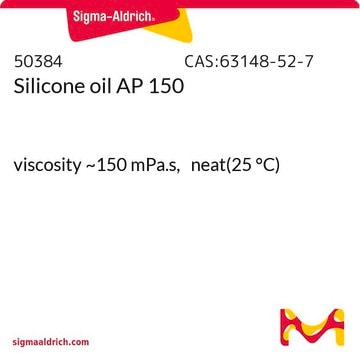146153
Silicone oil
for melting point and boiling point apparatuses
About This Item
Productos recomendados
vapor density
>1 (vs air)
vapor pressure
<5 mmHg ( 25 °C)
5 mmHg ( 20 °C)
type
for melting point and boiling point apparatuses
parameter
−40-350 °F temp. range (−40-175 °C)
refractive index
n20/D 1.403 (lit.)
viscosity
45.0-55.0(25 °C)
bp
>140 °C/0.002 mmHg (lit.)
density
0.963 g/mL at 25 °C
¿Está buscando productos similares? Visita Guía de comparación de productos
Application
- for melting-point and boiling-point apparatus
- in membrane contactors to impregnate fibers
- on rheometer samples (chicken skin and bovine gelatin) to prevent evaporation during heating using temperature sweeps and frequency sweeps
Biochem/physiol Actions
Features and Benefits
- High viscosity
- Low water solubility
- Low vapor pressure
Storage Class
10 - Combustible liquids
wgk_germany
WGK 1
flash_point_f
214.0 °F - closed cup
flash_point_c
101.1 °C - closed cup
ppe
Eyeshields, Gloves
Elija entre una de las versiones más recientes:
Certificados de análisis (COA)
¿No ve la versión correcta?
Si necesita una versión concreta, puede buscar un certificado específico por el número de lote.
¿Ya tiene este producto?
Encuentre la documentación para los productos que ha comprado recientemente en la Biblioteca de documentos.
Los clientes también vieron
Nuestro equipo de científicos tiene experiencia en todas las áreas de investigación: Ciencias de la vida, Ciencia de los materiales, Síntesis química, Cromatografía, Analítica y muchas otras.
Póngase en contacto con el Servicio técnico






